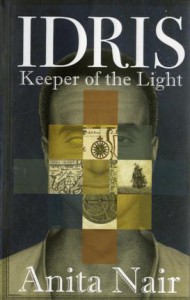“Idris” by Anita Nair, book review ( 6 December 2014, The Hindu)
 ( My review of Anita Nair’s Idris was published in the online edition of the Hindu Literary Review on 6 December 2014. Here is the url: http://www.thehindu.com/features/lit-for-life/journeys-galore/article6667608.ece . It will be published in the print edition on 7 December 2014. This novel has been shortlisted for the Hindu Lit Awards 2014 as well. The winner will be announced in January 2015.)
( My review of Anita Nair’s Idris was published in the online edition of the Hindu Literary Review on 6 December 2014. Here is the url: http://www.thehindu.com/features/lit-for-life/journeys-galore/article6667608.ece . It will be published in the print edition on 7 December 2014. This novel has been shortlisted for the Hindu Lit Awards 2014 as well. The winner will be announced in January 2015.)
He knew the folly of having friends. Friendship was a responsibility; it demanded making an effort to nurture relations and never asking why. It meant expectations and subsequent disappointments. A lone traveller needed no friends; what he needed to cultivate were acquaintances. (p.21)
Idris Maymoon Samataar Guleed is from Dikhil, a small place between Abyssinia and Somalia. He is a middleman who facilitates trade in anything — textiles, camels, spices, pearls, diamonds — but draws the line at the lucrative business of slaves. He arrives in Kozhikode, on the Malabar Coast, on the persuasion of a Yemeni merchant to attend the biggest cattle fair in the world—Vaniamkulam chanda. He gets separated from the Yemeni group and decides to wait the night out by a pond in a home. As it happens, it belongs to a Nair. He meets Kuttimalu, mother of his son, Vattoli Kandavar Menavan. When the boy is born, the midwife reminds the family the infant is the image of Kuttimalu’s grandfather. Otherwise Kandavar — who was as black as the night like his father — and his mother are in danger of losing their caste and being excommunicated.
Ten years later, in 1659, Idris returns to Kozhikode to witness the Mamangam festival at Thirunavaya. At the Mamangam, the Chaver Pada or Suicide Squad wants to ambush the bodyguards of Aswathi Thirunal, the new Zamorin. Unknown to the Chavers, Kandavar is following them since he wants to join them since he is eager to participate like his older cousin, Kesavan, a Chaver and trained at Kalari. Idris spots the boy hiding behind a tree and prevents him from proceeding further. He realises that Kandavar is his son andwhisks him away from the place, but not before they witness Kesavan (Kandavar’s cousin) being dismembered. Discovering he has a son Idris readily accepts Chandu Nair’s offer to be their guest and show Kandavar “how to think of other things, rather than grooming himself for certain death 12years from now”.
Idris takes his son under his wing. At Nair’s behest, Idris enrolls Kandavar in a different Chaver to the one the family traditionally went to—to prevent his head from being filled with “stuffed with nonsense like honour and pride in death”. But Idris gets restless and wants to proceed with his voyage. Persuaded by the Nair clan, he takes his son along too. They travel to Serendippo, contemplate trading in silk since the Dutch pay a good price for it, go pearl diving at Tharangambadi, but the ultimate aim is to reach Golconda diamond mines. Idris is curious about the “stones that turned men into hyenas…ready to lie and betray; worse, to kill and plunder”. It takes them over a year to travel and explore before returning home to Kozhikode.
In Keeper of the Light, the first of a trilogy, the recurring themes of Anita Nair’s fiction —gender and caste — are explored once more with competence. The rigid caste structures are challenged by the existence of the “family” of Idris, Kuttimalu and Kandavar. The objectification and identity of a woman in relation to the presence of a man in their life, even in Kerala’s matriarchal society, are challenged in the story, leave a powerful impression. The four women —Kuttimalu, Margarida (a child prostitute), Madinat al-Yasmin (a widow) and Thilothamma (a wealthy farmer) — are all seen briefly, usually as Idris’s lovers, yet they are strong and independent women. As Thilothama says “Women should be like trees. Growing towards the light, shaped by the wind…” Even Kuttimalu’s Brahmin teacher “… didn’t think education was to be decided by gender; it was the mind that he sought to fill.” A sentiment that echoes Anita Nair’s firm belief in promoting literacy irrespective of gender, as exemplified in her officiating as a guru at a Vidyarambham ceremony at Bangalore on Vijayadasami day.
Literary fiction can be challenging to read. Its complexity comes from the sophisticated, layered, and nuanced writing. In Idris, the reader’s patience is tested as one has to grapple with a bewildering storyline in the opening pages, not made any easier by the liberal sprinkling of Malayalam words. Also some issues such as the rivalry between the Zamorin and Chavers is never explained. Yet Idris is a pleasure to read.
Anita Nair Idris: Keeper of the Light Fourth Estate, HarperCollins, Hb. Rs. 599.
6 December 2014
